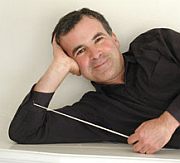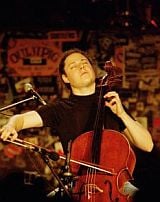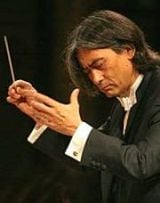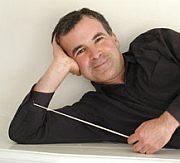
The other Auf Wiedersehen happened in the evening at Berkeley's First Congregational Church as a full house of Berkeley Symphony patrons and friends attended the second of two "Berkeley Akademie" (aka chamber recitals), and the close of Kent Nagano's 30-year tenure as that lucky orchestra's music directror.
First things first, the young string players did themselves proud for their skillful conductor, Benjamin Simon, and their orchestra. It's a pearl among the area's excellent youth orchestras and at 43, one of the eldest. In this, their season finale, they were hosts and musical colleagues of the prominent American cellist Matt Haimovitz.

Haimovitz first played Schubert's infectious "Arpeggione" Sonata, accompanied by the PACO strings in an effective arrangement of the piano part by Heinrich Klug. For the Adagio, Simon and Haimovitz reduced the orchestra to a nonet to produce delicate and affecting support to Haimovitz' subtle, tender treatment. Because it was written for another, now archaic instrument, singular even in its day, 186 years ago, Schubert's music lies high for the cello, but in the sweet spot for Haimovitz where he smoothly brought out the work's buoyancy and lyric charm. Simon conducted in his characteristically refined, contained, and always expressive style.
Haimovitz also gave the premiere of Luna Pearl Woolf's arrangements for string orchestra of Max Moon, her two imaginative cello songs inspired by children's stories. The first, " ... wore his wolf suit and made mischief" was fantastical, mercurial, high friction and contrast while "In the great green room ... " was exquisite, gentle, dreamlike, evaporating beautifully at the end.
Another new work, Monsoon Season (2009), comissioned by PACO from Stephen Feigenbaum, showed that the composer evidently has not taken a harmony course in his three years at the Yale School of Music. Nor is it energized by the rhythmic energy expected by its advertised commitment to popular styles. It is a micro-minimalist piece, static.
The concert opened with the first movement of Bedrich Smetana's String Quartet No. 1 in E Minor, nicely played by a quartet from the orchestra. For another ensemble, the Andante from Brahms' String Sextet No. 1 in B-flat proved challenging and not performance ready. PACO closed big with Josef Suk's sonorous Serenade for String Orchestra, Op. 6, a happy ending.

The Berkeley Akademie, a series of chamber concerts established by Nagano five years ago, has featured interesting repertory contrasts. This time, with no guest players, just 13 Berkeley Symphony musicians long accustomed to playing together, ensemble was top-notch. Nagano opened with Joachim F.W. Schneider's transcription of Bach's Concerto in the Italian Style, for solo harpsichord. He is a composer from Bavaria where Nagano directs the State Opera in Munich. Schneider's version is a colorful and entertaining reading of this popular work. The melodic lines dance phrase by phrase from one instrument to another. This makes it lively but distracts from the contrapuntal and linear continuity. It sounds like an echo of one of Stravinsky's free paraphrases, like his Pulcinella Suite. The outer movements "worked" well enough but not the Andante in which the dispersal of notes among the instruments made them sound lost.
The recent Bay Area neglect of Charles Ives (and 20th-century American music in general) was answered by an elegant, affectionate performance of his Third Symphony, "The Camp Meeting." It's not the rouser the name suggests, but rather the celebration of spiritual, revival meetings, one hymn paraphrased and developed after another. The melodies are recognizably
American hymns, of course, but most people have not the familiarity with them that evokes associations, personal memories or feelings for an audience today. No matter. The musical flow, more effortless and conversational than in other Ives orchestral pieces, found its quality of great and endearing charm, sentiment without sentimentality. What holds it out of the more frequently played repertory may be its insufficient contrast. Nagano led as fine and musical performance of it as I have heard, and the hearing of it in this chamber orchestra instrumentation made it it an especially personal, engaging experience.
Nagano then repaired to the balcony where he became`part of the audience for a splendid performance of the Beethoven work that was perhaps the most popular in his lifetime, the Septet. It was led by the Berkeley Symphony's concertmaster, Franklyn D'Antonio who, happily for this orchestra, had retired from his previous post, concertmaster with the Los Angeles Philharmonic while still in his playing prime, and resettled in the Sierra foothills to the east. The seven musicians gave a performance of the beloved Septet at an elegantly fashioned, beautiful level proper to the tribute to the honoree, their maestro. In response to the musicians' performance, their history with him and to the audience, Nagano delivered a most gracious farewell. His tribute to the musicians and the audience, which he called the crucial forces behind his career, couldn't have been more generous.He did promise to continue to be present, as he and his wife, the pianist Mari Kodama, will maintain residence in their brand new home in San Francisco's Cow Hollow district, even though he serves as music director of the far-off Montreal Symphony and Bavarian State Opera.

